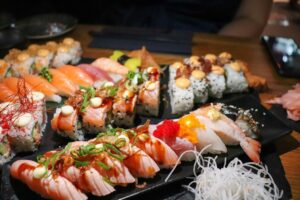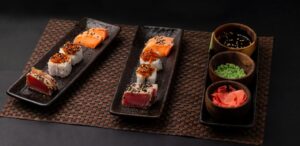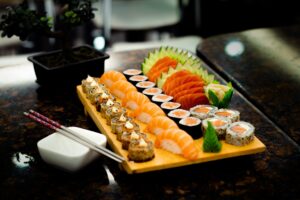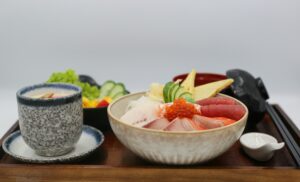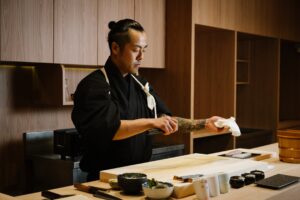
Japanese Sushi: A Culinary Art Form at Sushi Masa
At Sushi Masa by Ki-Setsu, every piece of Japanese sushi we craft tells a story of centuries-old tradition and meticulous artistry. As practitioners of authentic Edomae techniques in Singapore, we honor the legacy of Japan’s most revered culinary art form, renowned worldwide for its cultural significance.
When you step into a sushi restaurant, you’re not simply ordering dinner—you’re experiencing a cultural tradition perfected over generations. From the precise temperature of sushi rice to the seasonal selection of fresh seafood, every element reflects dedication to authenticity and excellence.
The Essence of Traditional Japanese Sushi
Traditional Japanese sushi represents far more than raw fish on rice. Authentic sushi is defined by perfectly seasoned vinegared rice, known as shari, which serves as the foundation for fresh fish and other carefully selected ingredients. The rice is seasoned with a blend of vinegar, sugar, and salt, essential for achieving the ideal flavor and texture.
The origins of modern Japanese sushi trace back to the Edo period in Tokyo, specifically Hanaya Yohei’s revolutionary nigiri sushi innovation in the 1820s. This pivotal moment transformed sushi from a preservation method into the fast, fresh dining experience we cherish today. Over time, many different types and various kinds of sushi have developed, including nigiri, maki, and regional specialties, each with unique characteristics. Yohei’s creation of hand-pressed rice topped with fresh fish established the template we continue to follow.

The evolution from ancient narezushi—a fermented rice preservation technique—to today’s celebrated cuisine shows the dynamic nature of Japanese cuisine. What began as preserving fish with fermented rice has become one of the world’s most sophisticated culinary art forms. We honor this transformation by maintaining traditional techniques while serving the freshest ingredients. As sushi has gained popularity worldwide, it has been adapted in other countries, resulting in unique regional variations reflecting local tastes. In many regions, sushi has diversified to include other ingredients as fillings, toppings, or accompaniments, which contribute to the unique flavors and culinary styles found in different areas.
Why do we honor these traditions so meticulously? Because authentic Japanese sushi requires not just technical skill, but deep respect for the cultural heritage that created these techniques. Our preparation methods, from rice seasoning to fish handling, follow practices passed down through generations of dedicated itamae, preserving the integrity of this remarkable cuisine for future generations to appreciate.

Classic Sushi Varieties We Master at Sushi Masa
Real commitment to traditional techniques ensures every sushi variety served represents authentic Japanese craftsmanship. Each style requires specific skills developed through years of practice under master chefs trained in Japan.
Among these classics is box sushi, or oshizushi. This style uses wooden molds to press layers of rice and toppings into a rectangular shape. Box sushi has deep regional significance, especially in Osaka and Nara, where it originated as an ancient preservation technique and remains a celebrated local specialty.
Another classic variety is chirashi, or scattered sushi, which is served in a bowl. Chirashi features sushi rice topped with an assortment of fresh ingredients, making it a visually appealing and popular way to enjoy sushi in a bowl format.
Nigiri Sushi – The Crown Jewel
Nigiri sushi is the ultimate expression of the sushi chef’s art. Hand-pressed sushi rice, perfectly seasoned and warmed to body temperature, forms the base for premium fish selections including chu-toro (medium fatty tuna), delicate kohada (gizzard shad), prized uni (sea urchin), and classic toppings such as egg (tamago), octopus (tako), shrimp (ebi), and crab. Each piece requires precise technique to balance rice and fish.
Rice is pressed just firmly enough to hold while maintaining a light texture that dissolves on the tongue. Fish, cut at precise angles with traditional yanagiba knives, is placed for visual appeal and optimal flavor.
Seasonal selections include winter hirame (fluke), spring tai (sea bream), summer aji (horse mackerel), and autumn sanma (Pacific saury). This rotation ensures diners enjoy each fish at its peak flavor.
The rice-to-fish ratio in authentic nigiri is refined over generations. Too much rice overwhelms the fish; too little fails as a foundation. Chefs perfect this balance to deliver the harmonious flavor defining exceptional Japanese sushi. For tradition, nigiri is often served on a bamboo leaf, acting as a natural plate and reflecting Japanese aesthetics.
Maki Sushi Traditions
Maki sushi includes several styles serving specific roles in traditional meals.
Hosomaki
Hosomaki features thin, nori wrapped rolls with single ingredients like tekka (tuna) and kappa (cucumber), wrapped in crisp nori seaweed and cut into rounds. These simple rolls highlight individual flavors and texture.
Futomaki
Futomaki celebrates rolled sushi with thick rolls featuring multiple ingredients, traditionally served during festivals. Different versions include seasonal vegetables, cooked seafood, and pickled items arranged in colorful patterns. Vegetarian and meat options are available, with fillings like assorted vegetables or cooked meat and sauces for added flavor.
Uramaki
Inside-out rolls, or uramaki, have rice outside and nori inside. Developed in Los Angeles, they are popular in Western countries, offering a twist on traditional Japanese sushi rolls. This style of sushi roll offers a different texture and presentation compared to traditional maki.
Temaki
Temaki, also known as hand roll, are freshly made to maintain nori crispness. These cone-shaped rolls filled with rice and various ingredients must be eaten immediately, perfect for interactive dining at sushi counters.
Gunkan Maki
Gunkan maki, the “battleship” style, provides a vessel for delicate ingredients like ikura (salmon roe) and flying fish tobiko. The nori wall wrapped around seasoned rice holds these precious toppings that might otherwise fall from nigiri.
Premium Ingredients That Define Our Sushi
Our sourcing philosophy centers on direct relationships with suppliers at Tokyo’s Toyosu Fish Market, ensuring we receive the same quality fish served in Japan’s top sushi restaurants. This commitment to premium ingredients forms the foundation of every dish.

The Foundation: Perfect Sushi Rice
Koshihikari short-grain rice is our base, prepared using traditional methods with a special vinegar blend. This premium rice, grown in Japan’s ideal conditions, offers perfect texture and subtle sweetness that complements our seafood.
Temperature control is crucial—our sushi rice is served at human body temperature (98.6°F) for optimal texture and flavor release. This ensures the rice feels neither warm nor cold, creating the seamless experience that defines exceptional Japanese sushi.
Our rice seasoning combines aged rice vinegar, organic sugar, and kombu (kelp) in proportions refined through generations of sushi masters. Vinegar provides the tang, sugar balances acidity, and kombu adds umami depth.
Daily preparation rituals start hours before service, including careful washing, precise water ratios, and controlled steaming. Rice is seasoned while warm using traditional wooden shamoji paddles and hangiri tubs for proper cooling and seasoning.
Pristine Seafood Selection
Direct supplier relationships in Japan enable same-day freshness rivaling Tokyo’s best sushi-ya. Fish arrives via air transport, maintaining the cold chain to preserve delicate textures and pure flavors that define premium sashimi-grade seafood.
Seasonal fish include spring sea bream with delicate sweetness, summer conger eel glazed traditionally, and autumn mackerel at peak oil content. These rotations reflect the Japanese principle of celebrating ingredients at their natural best.
Aging process for certain fish, especially tuna, enhances umami through controlled maturation. This traditional jukusei technique allows enzymes to break down proteins and concentrate flavors, creating the deep tastes characterizing the finest fatty tuna.
Choosing wild-caught or farm-raised fish depends on species and season. Wild-caught is preferred for superior flavor and texture, but responsible aquaculture can produce excellent results. Chefs must evaluate each delivery to ensure optimal quality.

The Art of Sushi Preparation at Sushi Masa
Traditional tools underpin our process. Yanagiba knives, forged with ancient Japanese steel techniques, provide razor-sharp edges for clean cuts preserving fish texture. Hangiri rice tubs, made from Japanese cypress, help achieve perfect rice temperature and moisture. Shamoji paddles, also wooden, allow gentle rice handling maintaining delicate grains.
Temperature control extends throughout preparation and service. Fish is stored at precise temperatures to maintain freshness and prevent protein breakdown. Rice temperature is constantly monitored to ensure perfect nigiri.
Presentation philosophy emphasizes simplicity, highlighting natural beauty and flavors. We avoid unnecessary garnishes or complicated arrangements that distract from the pure essence. Every element enhances the tasting experience.
Why prepare each piece individually to order? Because Japanese sushi is meant to be consumed immediately. The brief moment when rice warmth meets cool fish creates the ideal experience that cannot be preserved. Immediate service ensures every bite delivers the intended flavor.
The Omakase Experience: Chef’s Selection
Omakase embodies trust-based dining, where “I leave it up to you” invites experiencing the chef’s highest artistry. At Sushi Masa, the best omakase represents the ultimate expression of seasonal Japanese sushi, curated by Chef Masa who creates progressive flavor journeys building from light, delicate tastes to rich, intense experiences.
Our chef curates seasonal tasting menus reflecting deep understanding of ingredient relationships and flavor progression. We begin with lighter fish like hirame or tai, gradually introducing medium-bodied options like aji or kohada, culminating with indulgent fatty tuna or rich uni for a satisfying conclusion. The omakase often includes miso soup as a traditional side and may end with Japanese dessert for a balanced meal.
Sake pairing from our curated collection enhances each course with complementary flavors. Our selection includes junmai styles for delicate fish, robust junmai ginjo for richer dishes, and special seasonal offerings reflecting the same timing attention as the food menu.
Intimate counter seating and direct chef interaction create connections transforming dining into cultural exchange. Guests observe traditional techniques and learn about ingredient selection, preparation, and cultural significance, enriching the meal beyond consumption.

Sushi Etiquette and Appreciation

- Proper use of chopsticks versus hands reflects traditional Japanese customs, enhancing the sushi experience.
- Nigiri sushi is traditionally eaten with fingers, allowing better feel and control over delicate pieces.
- Sushi types served in bowls, like scattered sushi (chirashizushi), are eaten with chopsticks or spoons, showcasing diverse serving styles.
- Different sushi types such as nigiri, maki, and chirashi have their own etiquette; following proper eating methods enhances enjoyment and appreciation of Japanese sushi.
- Wasabi and soy sauce require proper application understanding:
- Real wasabi (not common horseradish substitutes) is placed between fish and rice by the chef.
- Soy sauce should be applied sparingly to the fish side of nigiri, avoiding soaking the rice to preserve seasoning and texture.
- Gari (pickled ginger) is used to cleanse the palate between fish varieties, not as a sushi topping.
- Its subtle acidity and spice reset taste buds, allowing full appreciation of each piece.
- Timing is crucial—eat sushi immediately after preparation for optimal temperature contrast and texture.
- The moment when rice warmth meets cool fish creates the ideal experience, which is lost if sushi sits even for minutes.
- Showing appreciation to the itamae (chef) reflects cultural values.
- Simple words like “oishii” (delicious) or “arigato gozaimasu” (thank you) show respect.
- This creates a positive atmosphere, making the omakase experience special.

Why Choose Authentic Japanese Sushi at Sushi Masa
Our commitment to preserving traditional Edomae sushi techniques sets us apart in Singapore’s dining scene. At Sushi Masa by Ki-Setsu, we focus on delivering an authentic Japanese sushi experience that honors the heritage and craftsmanship of Edo-style sushi. Unlike many restaurants that offer fusion or casual sushi, we emphasize precision, quality, and respect for time-honored methods that define true Japanese sushi.
Chef Masa underwent rigorous training and adhered to traditional preparation techniques, ensuring each piece is crafted with care and expertise. We source premium ingredients directly from Japan, including seasonal fresh seafood and the finest sushi rice, to replicate the flavors found in Tokyo’s renowned sushi establishments.
The menu at Sushi Masa features a curated selection of seasonal fish and delicacies, allowing diners to enjoy the best offerings throughout the year. Our omakase experience highlights the natural flavors of each ingredient, paired with complementary dishes such as light tempura and miso soup to complete the meal.
We invite you to immerse yourself in the artistry and tradition of Japanese sushi at Sushi Masa by Ki-Setsu. For reservations and details about our seasonal menu, please visit https://kisetsu.com.sg/ or contact us directly. We look forward to welcoming you and sharing the timeless craft of authentic Japanese sushi.

